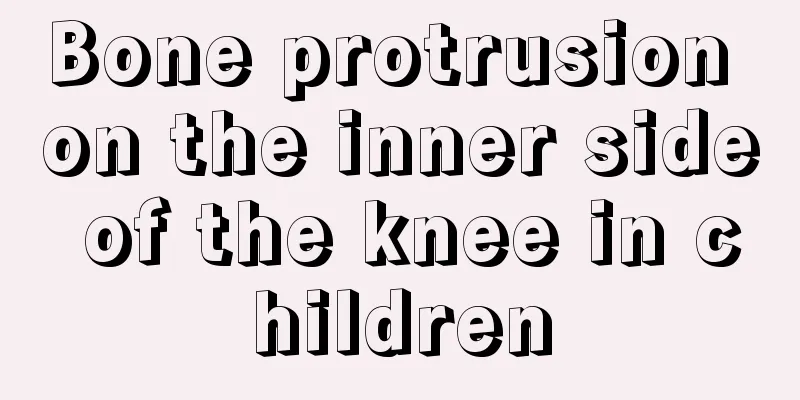Bone protrusion on the inner side of the knee in children

|
If the bones on the inside of a child's knee protrude, it may be caused by X-legs. We know that X-legs are a common form of legs, also known as genu valgum. At this time, parents should take their children to the hospital for examination. If it is indeed the case, it should be corrected in time through certain methods, especially for children who are in a good period of development. The correction effect will be better at this time. The scientific name of "X-shaped legs" is genu valgum. There are more than 40 diseases that can cause it, but more than 70% of knock knees are due to rickets. The definition of "X"-shaped legs is: a deformity characterized by the two knees touching each other and the inner ankles of the two feet being separated and unable to come together when the two lower limbs are naturally stretched or standing. It is caused by congenital heredity, acquired malnutrition, and incorrect sitting and walking posture in early childhood, resulting in an abnormal bone and joint phenomenon caused by femoral adduction, internal rotation and femoral abduction and external rotation. X-leg correction method Method 1: Stand in a "one" shape with your knees and feet spread out to the left and right. Straighten your knees and connect the four points of the thigh, inner knee, calf, and heel into a straight line, and keep your legs together and standing straight. Bend your elbows, put your hands on your hips, press your shoulder blades down and back, and keep your whole body straight and in the same plane. Bend your left and right knees outwards to make your calves form a diamond shape. Let your pelvis sink vertically. Do not tilt your upper body forward or backward. Keep your upper body straight. Do not release your heels. Bend your knees for 10 seconds, then stand up again. Repeat 3 times. Bend your knees and sit shallowly at two-thirds of the chair, open your knees slightly to the left and right, with the distance slightly wider than the shoulder width, keep your back straight, but be careful not to lean against the back of the chair, bend your knees and lift your left leg, put your left foot on the right thigh, and put your hands on your knees and left foot respectively. Use your right hand to slowly press your ankle towards you for 10 seconds, and do it 3 times on each side. Method 2: Sit shallowly and stretch your legs. Bend your knees and sit shallowly at 2/3 of the chair. Open your knees slightly to the left and right, with the distance between them slightly wider than the width of your shoulders. Keep your back straight, but be careful not to lean against the back of the chair. Bend your knees and lift up your left leg. Place your left foot on your right thigh and place your hands on your knee and left foot respectively. Use your right hand to slowly press your ankle towards you for 10 seconds, and do this 3 times on each side. |
<<: Bone protrusion on the outside of the child's knee
>>: How to guide children correctly
Recommend
Baby feels phlegm in throat when feeding
Many mothers say that when feeding their babies, ...
How to kill tooth worms?
Some children often feel toothache, and then ask ...
What should children pay attention to when swimming?
Children are the treasures of their parents and t...
How to deal with tooth decay in a three-year-old baby
Many people have had cavities when they were youn...
What to do if a one-year-old baby has athlete's foot
Athlete's foot is a contagious disease that c...
How to treat children’s allergic cough with traditional Chinese medicine?
Because children are young and have very poor phy...
2-year-old baby breakfast
Babies may show anorexia, poor appetite, and be p...
What are some warm-up exercises for children?
Young children are in the period of growth and de...
Symptoms of precocious puberty in children, parents must read
More and more children are entering puberty early...
Child walking on tiptoes
Children usually start learning to walk when they...
When should newborns take vitamin D?
It is very important to supplement nutrients and ...
What diseases are related to babies' constant coughing
When a baby keeps coughing, parents will be very ...
What will happen if your baby doesn't get vaccinated?
It is very necessary to vaccinate your baby. As t...
Can babies sleep on buckwheat pillows?
The baby's bones are not fully developed yet,...
How to educate a child who steals?
Why are some children particularly naughty and ig...









